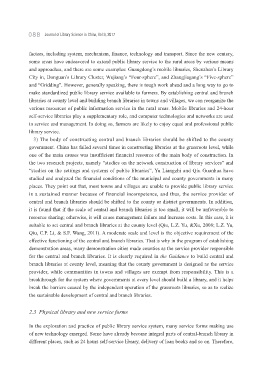Page 88 - JOURNAL OF LIBRARY SCIENCE IN CHINA 2018 Vol. 43
P. 88
088 Journal of Library Science in China, Vol.9, 2017
factors, including system, mechanism, finance, technology and transport. Since the new century,
some areas have endeavored to extend public library service to the rural areas by various means
and approaches, and there are some examples: Guangdong’s mobile libraries, Shenzhen’s Library
City in, Donguan’s Library Cluster, Wujiang’s “Four-sphere”, and Zhangjiagang’s “Five-sphere”
and “Gridding”. However, generally speaking, there is tough work ahead and a long way to go to
make standardized public library service available to farmers. By establishing central and branch
libraries at county level and building branch libraries in towns and villages, we can reorganize the
various resources of public information service in the rural areas. Mobile libraries and 24-hour
self-service libraries play a supplementary role, and computer technologies and networks are used
in service and management. In doing so, farmers are likely to enjoy equal and professional public
library service.
3) The body of constructing central and branch libraries should be shifted to the county
government. China has failed several times in constructing libraries at the grassroots level, while
one of the main causes was insufficient financial resource of the main body of construction. In
the two research projects, namely “studies on the network construction of library services” and
“studies on the settings and systems of public libraries”, Yu Liangzhi and Qiu Guanhua have
studied and analyzed the financial conditions of the municipal and county governments in many
places. They point out that, most towns and villages are unable to provide public library service
in a sustained manner because of financial incompetence, and thus, the service provider of
central and branch libraries should be shifted to the county or district governments. In addition,
it is found that if the scale of central and branch libraries is too small, it will be unfavorable to
resource sharing; otherwise, it will cause management failure and increase costs. In this case, it is
suitable to set central and branch libraries at the county level (Qiu, L.Z. Yu, &Xu, 2008; L.Z. Yu,
Qiu, C.P. Li, & S.F. Wang, 2011). A moderate scale and level is the objective requirement of the
effective functioning of the central and branch libraries. That is why in the program of establishing
demonstration areas, many demonstration cities made counties as the service provider responsible
for the central and branch libraries. It is clearly required in the Guidance to build central and
branch libraries at county level, meaning that the county government is designed as the service
provider, while communities in towns and villages are exempt from responsibility. This is a
breakthrough for the system where governments at every level should build a library, and it helps
break the barriers caused by the independent operation of the grassroots libraries, so as to realize
the sustainable development of central and branch libraries.
2.3 Physical library and new service forms
In the exploration and practice of public library service system, many service forms making use
of new technology emerged. Some have already become integral parts of central-branch library in
different places, such as 24 hours self-service library, delivery of loan books and so on. Therefore,

